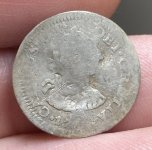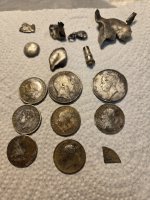I just heard a story from a very credible source about gold coins found on a property while ecavating a lot to pave it. About 20 years ago the owner of a paving company and hid crew were excavating a lot where a former bank once stood in preparation to pave it. while running the machine the owner noticed burlap bags in the dirt. When he got off to check them, he found numerous amounts of $5, and $20 gold coins from the early 1900's in them and on ground around them. He and is workers split the find without officially notifying anyone about the find. After they split it, his workers never showed up and he had to finish the paving job himself. He says that he didn't really have time to search for any more coins due to a time schedule to complete the job. I am just curious if there is anything under that lot still left, or in the unpaved ground around it. I know that I can't dig the blacktop if there was something there, but is there anyway to accurately detect for gold coins under a paved lot? It would love to know if there is anything there.
Upvote
0




